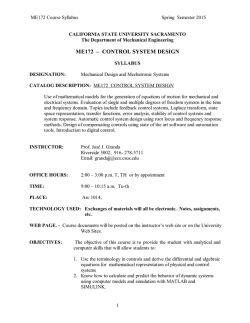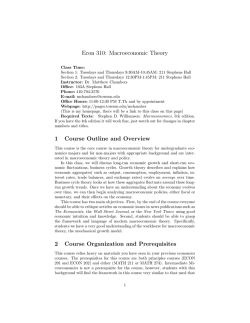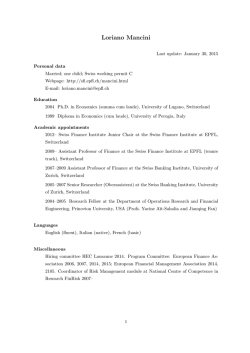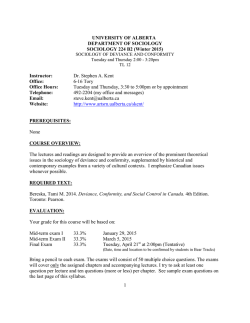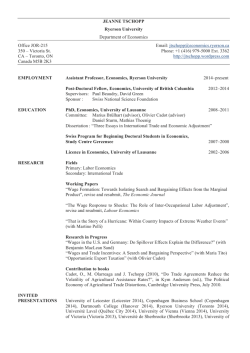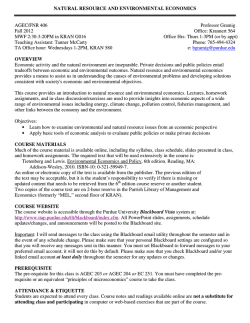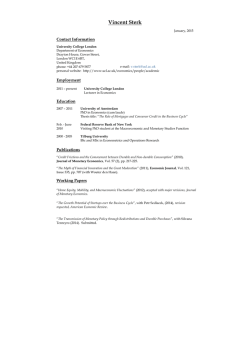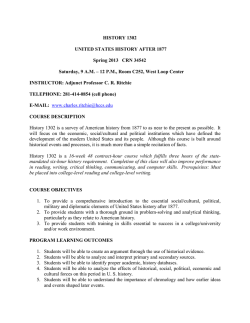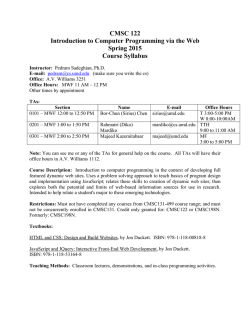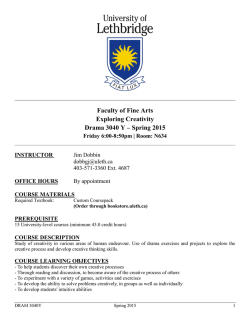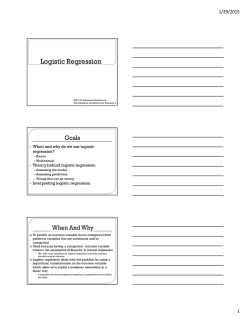
Koontz - The College of Agricultural Sciences
COLORADO STATE UNIVERSITY DEPARTMENT OF AGRICULTURAL & RESOURCE ECONOMICS Syllabus Instructor: Agricultural & Resource Economics / Economics 535 Applied Econometrics Stephen R. Koontz Fall 2014 Office: B-324 Clark Building Phone: 491-7032 E-Mail: [email protected] Class Meeting Time and Location: C-360 Clark Building from 2:00-3:15 p.m. TR. Office Hours: 12:30-2:00 p.m. M-F. The instructor maintains an open door office policy. However, it is efficient to make an appointment. I am also willing to meet informally outside of class hours to discuss readings, home works, and the methodology of econometrics, research, and science – and maybe software. Students in the course need to take the initiative here. Course Objective: Econometric techniques applied to testing and quantification of theoretical economic relationships drawn from both microeconomics and macroeconomics. This is a course in applied econometrics. The main objective of the course is to initiate students to the practice of econometrics in applied research. The course will emphasize development of quantitative, statistical, and analytical skills. The process of practicing applied econometrics involves understanding model development, model specification, sensitivity and specification testing, data handling, hypothesis testing, model interpretation, and use. Prerequisites: Students need some familiarity in statistical methods, statistical theory, and differential calculus. The formal course requirements are the following: EC 304 (Intermediate Macroeconomics) or EC 306 (Intermediate Microeconomics) and EA/EC 335 (Introduction to Econometrics). Enrollment in ECON 501 and/or AREC 506 is not required but is helpful. Course Material: Assignments will be made from the required texts. Supporting and related reading will be identified in the recommended texts. Required: Damodar N. Gujarati and Dawn C. Porter. Basic Econometrics, Fifth Edition. McGrawHill/Irwin, 2009. Recommended: Peter Kennedy. A Guide to Econometrics, Sixth Edition. MIT Press, 2008. Recommended: William H. Green. Econometric Analysis, Sixth Edition. Prentice Hall, 2008. 1 Lecture overheads and class handouts will be posted at http://webdoc.agsci.colostate.edu/koontz. Students should make sure the email address tied to their eID is up-to-date and a campus email is preferred. Grading: Examinations and assignments for the course will total approximately 700 points. The approximate distribution of these points is as follows. First Examination Second Examination Problem Sets Assignments Final Examination 100 points 100 points 250 points 100 points 150 points The instructor reserves the right to change the percentage of points in the course requirements. The most likely change will be to assignments. But, any changes will be communicated. Final grades for the course will be determined on the standard modification to the 90-80-70-60 scale that accompanies Graduate School courses. Any student receiving less than 80% on the graded course material will receive a “C.” There are no exceptions and no negotiation. (In addition, any student receiving less than 60% on the graded course material will receive an “F.” This rule will be exercised in unique cases.) If a student shows strong improvement in exam scores over the semester, the instructor reserves the right to weigh the end-of-semester exams more heavily when calculating that student=s final grade. The instructor will make minimal use of the +/- grading system. Assignments: There will be three in-class examinations. There will be two 100-point exams given during the semester. Make-up exams will be the option of the instructor. If any student must miss an exam due to an emergency, or due to a scheduling conflict, which is communicated to the instructor prior to the exam then the student’s final grade may be based on the other exams taken. There will be a 150-point final exam at the end of the semester. There will be two types of graded out-of-class assignments. Student teams will be assigned approximately five problem sets. Teams will consist of two individuals. This work will expose the teams to a variety of methods and data types. The instructor will provide the data and ask a variety of questions related to the modeling process and economic interpretation. Student teams will perform the analysis and write a short professional report describing the results of the analysis and answering the questions. Problem sets are to emphasize communication – and the not the printing of regression results. I also expect there to be across-team communication but each team must have a unique report. Problem sets will be about one week in duration and made about every two weeks. Students will need to become familiar with at least one spreadsheet and statistical regression software package. Students will also have assignments to complete individually. These assignments will be less lengthy, will involve derivations, will give each student the opportunity to practice and display individual skills, and will not necessarily be software based. Students will complete this work independently. 2 Academic Integrity Policy: University academic integrity policies are enforced. Students should read and know these policies. The policies are published in the General Catalog. Submitting any assignment implies that you have complied with the University Academic Integrity Policy. Final Exam: The final exam is scheduled for Monday, December 15, from 6:20 p.m. – 8:20 p.m. Any exceptions to this must be cleared with the instructor by Monday the last week of class. The exam will be comprehensive with a slightly heavier influence on the untested final portion of the course. Course Philosophy: My approach to teaching econometrics is to teach applications and examples. That is how I learn and that is what largely motivates my interests. Theory is important, both economic and econometric. Forgetting your theory will lead you to make enormous mistakes. But, I believe students can be motivated to learn theory through interesting applied problem solving. You probably chose the profession you did because of a desire for career success or desire to do something good rather than because you want to be a scholar. Further, this is a Land Grant university. We are supposed to do applied research. I want you to leave this course with a set of skills and an ability to conduct applied research using econometric methods. This goal will be addressed through the two types of graded out-of-class assignments, readings, and the material covered in lectures. The problem sets are to expose the student to a breadth of topics. Different economic problems require different methods. Likewise, different models have different problems which must be attended to for the researcher to draw the correct conclusions from those models. Linear regression is a good tool for an applied economist to know how to use, but it is not the only tool they must know how to use. The assignments are to develop the student’s skills in thinking and producing analytical work. Econometrics is not all about getting the answer out of your computer software. It is also about using the tools of statistics and mathematics to focus computational efforts and economic thinking. The instructor will periodically digress into discussions of professional expectations and philosophy of science. Students are expected to be interested, ask and answer questions, contribute to the discussion, and link the big picture to the mechanics of course materials. 3 Course Outline Topics Reading Assignments Introduction to Econometrics What is econometrics? Regression Estimation Least Squares and Maximum Likelihood Goodness of Fit Model Interpretation and Use Regression Estimation and Inference Significance Testing Model Building Regression Basics Dummy Variables Collinearity and Influential Data Exam 1 Serial Correlation Testing, Consequences, Correction Generalized Least Squares Heteroskedasticity Testing, Consequences, Correction Maximum Likelihood Models Dynamic Models Lagged Dependent Variables, Distributed Lags Panel Data Fixed and Random Effects Exam 2 Probit and Logit Estimation and Interpretation Simultaneous Equations Identification 2SLS and 3SLS Time Series Autoregressive and Moving Average Processes Stationarity and Co-integration 4 COLORADO STATE UNIVERSITY DEPARTMENT OF AGRICULTURAL & RESOURCE ECONOMICS Survey Agricultural & Resource Economics / Economics 535 Applied Econometrics Name: Department and Degree Sought: Time in Program: Previous Course Work (List graduate or highest level undergraduate courses): Agricultural Economics: Economics: Statistics: Mathematics: List statistical and spreadsheet software with which you are familiar: Fall 2014
© Copyright 2026
